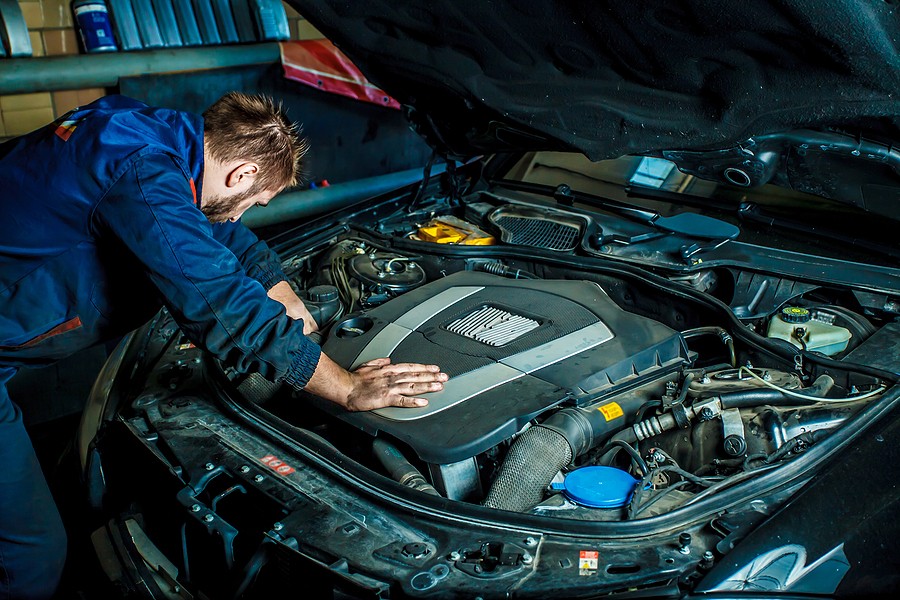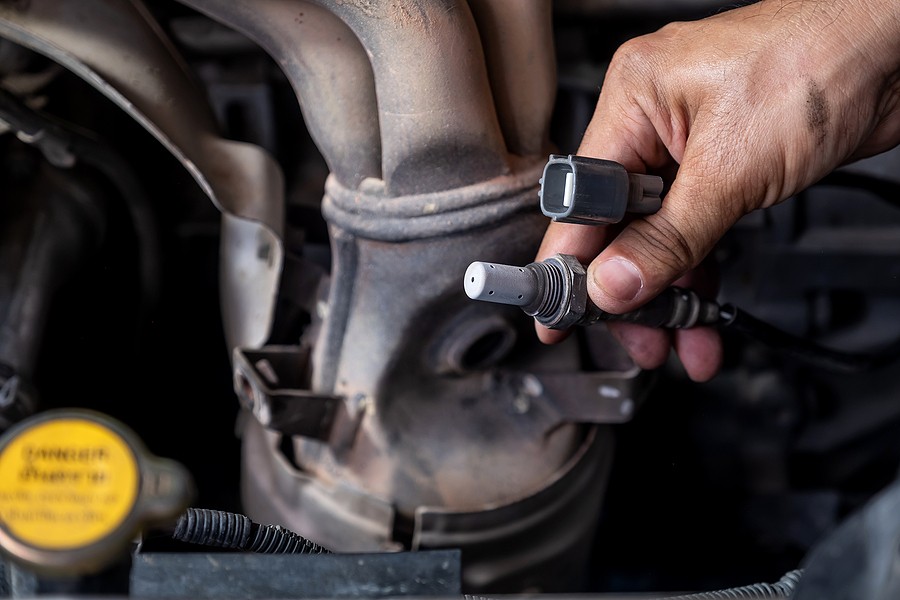Here are the top reasons why you need to replace your oxygen sensor:
- Failing the emission test
- Check engine light illuminating
- Engine misfiring and stalling
- Reduced fuel economy
- Reduced engine performance
- Loud engines noises
- Weird exhaust smoke
- Rotten egg smell from the exhaust
- Damages in the catalytic converter
- Engine overheating
Although the oxygen sensor is a minor component in your vehicle, it plays a critical role in how your engine performs and how many harmful gases leave the vehicle in the environment.
The oxygen sensor is responsible for communicating with your vehicle's internal computer and telling the computer how much oxygen is coming inside the cylinders for the combustion process. This way, your vehicle's computer decides on the amounts of fuel to be injected into the cylinders, the amount of exhaust, and some other important decisions in the combustion process.
Since the oxygen sensor is not designed to last forever, there is a point when it goes bad, and that's where you have to be prepared because when it goes bad, it leads to tons of complications that impact your vehicle's overall performance.
This article walks through the 10 most important symptoms to help you understand, “why do I need to replace the oxygen sensor?” It also highlights potential expected repair costs for replacing your oxygen sensor, along with whether you can drive when the oxygen sensor is bad or not.

Why do I need to replace the oxygen sensor?
As we mentioned before, the oxygen sensor has a critical role, and you want to make sure that your vehicle has a perfectly running oxygen sensor all the time. So therefore, understanding what symptoms look for when the oxygen sensor goes bad is extremely important for every drug, and it should be one of the first skills you have to learn about your vehicle.
Let's look at some of the common symptoms to help you understand why you need to replace the oxygen sensor.
1. Failing the emission test
When the oxygen sensor fails, you will not pass the emission test. As we mentioned earlier, the sensor is the way to communicate with the engine and tell how many bad and harmful gases are leaving through the existing system.
Therefore, consider checking the oxygen sensor when you feel that you're failing that mission just frequently because it could be that faulty component causing you to lose your time and money.
2. Check engine light illuminating
When the check engine light illuminates, it could indicate a long list of potential culprits. However, sometimes it can be tricky to determine which culprit is unless you have a scanner that can go inside the vehicle computer and determines the faulty components.
However, one of the very common reasons for our check engine light illuminating is a bad oxygen sensor. Therefore, your mechanic should have the right tools to tell him what is going on in terms of the check engine light and once he confirms that it's the faulty oxygen sensor, you need to replace it immediately. Otherwise, you would check engine light will not go away no matter what.
If you don't want to wait until you get to the mechanic and confirm whether that check engine light is related to a bad oxygen sensor or not, you can't do it on your own. In other words, you can invest in a simple component like the OBD scanner that reaches your vehicle's computer and tells you what error the computer is suffering from.
Depending on the scanner, sometimes it might provide more details about what the error means, but it's a very simple and easy thing to find on Google. So all we have to do is look for the error in the potential check engine light illuminating errors and understand what is causing it.
Many advanced scanners provide potential repair options and repair costs to give you the full picture before even reaching your mechanic. However, these counters can be a bit pricey. As a result, they're typically recommended for mechanics who check on vehicles frequently rather than for individuals who deal with a problem once in a while.

3. Engine misfiring and stalling
Another important symptom that you will notice when the oxygen sensor fails is engine misfiring and engine stalling. By understanding and hearing these, you should no longer ask yourself why I need to replace the oxygen sensor!?
If you started noticing that the engine is not operating properly and your vehicle frequently stalls, check the sensor and replace it. Engine stalling is critical, and it can easily put you in serious situations, including major car crashes.
4. Reduced fuel economy
The oxygen sensor has to do with how much balance between the air and fuel in your cylinders. When it goes bad, it's not surprising to deal with a reduced fuel economy, especially if your engine tries to pull more fuel to generate the required energy without understanding that the issue has to do with the amount of air in the engine.
Therefore, consider checking the oxygen sensor if you feel that you're visiting the gas station more frequently than before.
Reduced fuel economy is another symptom related to some other faulty component, which means you cannot immediately replace the oxygen sensor because you notice that your vehicle uses too much fuel. Instead, your mechanic needs to take a quick look and perform the third inspection to confirm the faulty component before deciding on any repairs.

5. Reduce engine performance
Obviously, with all the mentioned consequences of a failed oxygen sensor, it is also not surprising to deal with and reduce vehicle engine performance. You will see issues with engine stalling, but you will also notice that your vehicle is not producing the right amount of energy it used to do.
For example, you hit the gas pedal and feel that the car is not accelerating as fast and not generating what's needed, corresponding to the amount of fuel pushed inside the cylinders.
To eliminate this problem, consider replacing the oxygen sensor as soon as possible.
6. Loud engines noises
Sometimes your vehicle might start making weird noises coming from the engine compartment. These noises could be related to some other problems, but the oxygen sensor could be of the faulty components.
We typically recommend never ignoring any weird noises coming from your vehicle. Whether these noises come from the engine or some other components, they should be taken seriously. Sometimes detecting the noises as early as possible helps prevent major complications and save you thousands of dollars on repair.

7. Weird exhaust smoke
The exhaust should not have any color in most modern vehicles. Sometimes, older cars might have clear white smoke, but you shouldn't see obvious color out of the exhaust system.
If you notice black smoke coming from the exhaust and if the smoke is associated with some flames, this is a very severe scenario, and you got to stop your vehicle immediately and pull over to a safe location to check what's going on.
Most likely, you will be dealing with a failed oxygen sensor that caused all of these consequences. We're hoping that you don't deal with this situation by this point because if you couldn't detect the last symptoms, you shouldn't reach this point, which is considered very risky.
8. Rotten egg smell from the exhaust
When the oxygen sensor fails, it allows the wrong chemicals to leave the vehicle through the exhaust smoke. The easiest way to detect problems with the exhausted system, including the faulty oxygen sensor, is when you notice a strong rotten egg smell that indicates some sulfur in the exhaust smoke.
You should never ignore this problem because it might indicate a failing catalytic converter which means tons of money and repair costs.
9. Damages in the catalytic converter
Sometimes, problems in a simple component like the oxygen sensor might lead to severe scenarios by damaging some of the most expensive components like the catalytic converter. If the catalytic converter goes bad, say goodbye to your vehicle because repair costs can pile up and approach your vehicle's value!
10. Engine overheating
Finally, a failed oxygen sensor can easily lead to engine overheating because of the vehicle’s performance and combustion process imbalance. Too much energy will be generated at the wrong time, and lots of heat will impact the engine compartment.
Therefore, consider checking the oxygen sensor when you deal end overheating while checking the other potential common reasons. Note that most engine overheating problems are not typically because of a faulty oxygen sensor; they are most likely related to some problems in the cooling system that prevented cooling from running around the engine or some other problems that caused this issue.
However, consider checking the oxygen sensor if you run out of potential causes.

How much does it cost to replace an oxygen sensor?
What are you confirmed that the oxygen sensor failed, you need to replace it, and the next step is to understand how much you expect to replace the oxygen sensor? Typically, repair costs range from $329 and $379.
This price range is considered medium when it comes to car repairs. So it's not very cheap, but also, it's not very complicated and expensive.
Keep in mind that the mentioned costs range differs significantly depending on your vehicle's type and where you get the job done.
Can I drive with a bad oxygen sensor?
If the oxygen sensor fails, it will not immediately prevent you from driving your vehicle. However, it will show some complications like reducing engine performance, fuel economy, and other minor issues.
However, suppose you ignored a field oxygen sensor for more than a couple of days. In that case, it's easy to deal with other complications in significant components that could cost you thousands of dollars in repair if it is repairable.
Therefore, we highly encourage you never to consider continuing to drive your car if you have a bad oxygen sensor. Instead, you need to head to the mechanic immediately and have him replace the faulty components. Then, you enjoy your vehicle and extend the lifetime without introducing other damages to other components around the oxygen sensor.

Final thoughts
The oxygen sensor is critical in your vehicle and responsible for determining how much oxygen is inside the vehicle’s cylinders. This sensor determines the oxygen level and communicates with your engine about how much fuel needs to be injected and some other recommendations.
When the options and sensor fail, you have to replace them, and there are still many people who wonder why I need to replace the oxygen sensor? There are many symptoms and complications you will notice with the oxygen sensor fails, and that's where you have to replace it; otherwise, you won't be able to drive your vehicle safely, and you most likely not pass the emission test.
If your problems causing the oxygen sensor are more complicated and if the overall repair cost to fix your vehicle is more than 75% or more from your vehicle's value, you'd better sell this vehicle and buy a better one. Looking for someone to purchase your car? Check out Cash Cars Buyer!
Cash Cars Buyer is one of the top-rated car removal companies in the nation that guarantees to pay you the top dollars and provide you with free towing despite your living location around the United States.
Our process is very straightforward and doesn't take more than a couple of days to get your car removed safely and for the most money.
All it takes you is to:
- Describe your car's type and condition
- Receive our instant free quote
- Accept the quote
- Get your car removed and receive your cash payment on the spot!
To learn more about our process and our team, you can reach out to us by calling us at (773) 781-4363 or visiting our home page click on the free instant online offer.



